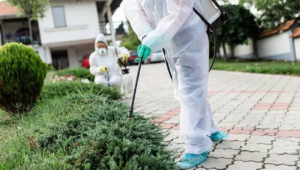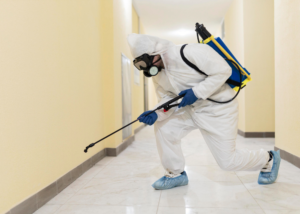Pest Control Meridian ID is a vital service that protects homes, families and businesses from the diseases and damage caused by unwanted pests. It also helps keep business operations running smoothly.
Garbage and compost piles should be disposed of daily to avoid an all-you-can-eat buffet for pests. Wood piles should be kept away from the house, as should tall weeds and brush.

Prevention is the best way to avoid pests, as it eliminates the need for treatments and prevents pest-related damages. It’s also more environmentally conscious than many other pest control methods. However, prevention is often a difficult goal to achieve, as pests can often be unpredictable. Continuous pests may be easily predictable under certain environmental conditions, such as specific temperature ranges and day lengths, but sporadic pests are more challenging to predict.
The simplest prevention measures include sealing cracks, holes, and gaps in exterior walls of a building or home and regularly inspecting the property to detect pest entry points. Regular trash removal and sanitizing of food containers helps prevent pests from seeking out sources of food, water, and shelter inside a structure. Keeping plants properly watered and trimmed helps reduce their attractiveness to insects and rodents. Regular sanitizing of mattresses, pillows, and rugs can help prevent the spread of bed bugs and fleas.
Preventive pest control can also involve identifying and training employees on the roles of each person when it comes to preventing pests in a commercial environment. This includes establishing a protocol for employees to follow upon bringing incoming merchandise into a facility and determining who is responsible on staff for inspecting and cleaning locker rooms. It can also mean establishing procedures for staff to report pests and their locations to a pest management professional, as well as defining what the responsibilities are of both the entomologist and the client in terms of exclusion, sanitation and maintenance.
The most effective pest control techniques involve a combination of prevention and suppression. For instance, a natural predator or parasite may be introduced into an area to reduce the population of a target pest. This may be augmented by other controls that affect the environment, such as weather conditions. For example, freezing temperatures, rain, and droughts can all change normal pest activity patterns and affect their rate of reproduction. This type of preventive pest control is called biocontrol. It also involves the use of biological agents, including nematodes, mycoplasmas, sterile males, and juvenile hormones.
Suppression
Suppression is the reduction of pest numbers or damage to an acceptable level. This usually involves a tradeoff between environmental, health and economic factors. Growers can use various methods to control pests. The most important step in determining a management strategy is accurate pest identification. The correct name, life cycle stage and physical features of a pest help determine appropriate management tactics. Accurate identification is also critical to cost-effectiveness, preventing the misuse of expensive and sometimes toxic pesticides. It is recommended that growers consult their commodity or industry organization, Cooperative Extension agent or State land grant university for assistance in pest identification.
Biological Control is the use of naturally occurring organisms, such as beneficial insects, mites or bacteria to suppress populations of damaging organisms. These organisms may be mass-reared in insectaries or obtained from other sources, such as weeds or wild animals, and released into cropping areas. They are often more effective than synthetic chemicals in managing certain pests, such as greenhouse whitefly and citrus psyllid.
The organisms that suppress pests are referred to as natural enemies. These can include predators, parasites or disease pathogens. Many of these organisms are found in the environment, but some, such as the nematodes that kill harmful soil grubs and the wasp that parasitizes the greenhouse whitefly, are available commercially. The purchase and release of natural enemy species, called augmentative biological control, is a common practice in greenhouses, nurseries and some fruit and vegetable fields.
Some natural enemies are host-specific and may require special handling and cultural practices to establish a population that effectively suppresses the target pest. For example, the predatory mite Amblysieus swirskii will only feed on thrips and certain types of whiteflies, but not spider mites. Similarly, the Bacillus thuringiensis subsp. kurstaki bacterium that controls caterpillars will not control beetles or grubs.
Other natural enemies are symbionts, such as bacteria and viruses that live on or in hosts and interfere with the host’s normal functions. Several methods can be used to identify the symbionts, including DNA analysis of faeces or a combination of genetic, morphological and behavioral traits.
Eradication
Pests include insects, rodents, fungi and viruses. They can damage food, crops, buildings and living spaces. Pest control refers to the processes and methods used to eliminate or manage unwanted organisms. In most cases, pest control focuses on the prevention or suppression of pests rather than their eradication. However, eradication is sometimes an achievable goal for certain organisms that threaten human or animal health or the environment.
Biological pest control uses natural enemies to limit pest populations. The natural enemies of pests are predators, parasitoids and pathogens. In biological pest management, the natural enemies are usually released into an area to increase their population and keep pest numbers low. This is accomplished by the conservation of existing natural enemies, the mass rearing and periodic release of new enemies, or the genetic manipulation of the pests themselves, such as releasing sterile males or using pheromones or juvenile hormones. One example of a biological pest control is the use of the bacteria Bacillus thuringiensis to kill caterpillars.
Physical pest control involves trapping or netting pests. This can be done in a home, such as putting up mouse traps or setting out baits, or in an entire facility like a manufacturing plant. This method often requires the help of a professional. It is important to know what type of pest is being targeted before selecting a trap or bait.
Chemical pest control includes insecticides, which are poisonous substances that kill bugs. These can be found in household products such as sprays and powders. In general, these types of pesticides work faster than biological controls, but they may also be harmful to humans and the environment when not used properly. It is important to read the label before using any chemical pest control product and to follow all instructions.
A pest infestation is a major concern for businesses, especially in the food and beverage industry. Pest control is an important part of hygiene management to protect the quality of the foods that are produced. In addition, a pest infestation can lead to costly fines or even shutdown of the facility if not controlled.
Natural Forces
The natural environment can sometimes control pest populations without any human action. Nonliving factors include weather, wind and temperature conditions that may affect pest behavior or death. Living factors can be bacteria, viruses, fungi or insects that attack or consume a pest. Plant resistance to the pest or its predators or parasites is another form of natural control.
When the occurrence of a particular pest cannot be prevented, or when eradication is impossible or impractical, it becomes necessary to reduce the problem using control methods. The goal of control is to limit the damage done by the pest so that production can continue. This can be accomplished by the use of resistant varieties, cultural practices that manipulate pest mating or host-finding behavior, judicious application of chemical pesticides and, in some cases, physical methods.
The classical example of successful biological control is the Vedalia beetle introduced to control cottony cushion scale on citrus. This beetle is a natural enemy of this pest that was accidentally brought into the United States from Australia in 1868. After a thorough study and quarantine to make sure the beetle did not have negative effects on native species, this natural predator was successfully released into California orchards in 1887. The result was the death of a few thousand of the pests.
There are many natural enemies that can be used to kill or reduce pests, such as plants that have a chemistry that repels the pest; chemical substances (pheromones) that confuse males and prevent reproduction; or juvenile hormones that keep earlier stages of the insect from developing into normal adult forms. However, pesticides often kill these natural enemies along with the pests they are supposed to control. Therefore, it is important to monitor the use of pesticides to ensure they are being used in a manner that does not destroy these beneficial organisms and reduces their effectiveness in killing or controlling pests. If the need for pesticides is deemed to be inevitable, then priority should be given to treatments that are highly targeted against the specific pest organism and that cause minimal harm to natural enemies.
